2008 Seat Ibiza 5D brake fluid
[x] Cancel search: brake fluidPage 184 of 260

Checking and refilling levels
182•
Avoid causing short-circuits in the electrical system, particularly at the
points where the jump leads are attached ⇒page 227. The battery could
explode.
•
Never touch the radiator fan. It is temperature controlled and could
start automatically, even when the engine has been switched off and the
key removed from the ignition!
•
Do not unscrew the cap on the expansion tank when the engine is hot.
If the coolant is hot, the cooling system will be pressurised!
•
Protect face, hands and arms by covering the cap with a large, thick
cloth to protect against escaping coolant and steam.
•
Always make sure you have not left any objects, such as cleaning cloths
and tools, in the engine compartment.
•
If you have to work underneath the vehicle, you must use suitable
stands additionally to support the vehicle, there is a risk of accident!. A
hydraulic jack is insufficient for securing the vehicle and there is a risk of
injury.
•
If any work has to be performed when the engine is started or with the
engine running, there is an additional, potentially fatal, safety risk from the
rotating parts, such as the drive belts, alternator, radiator fan, etc., and
from the high-voltage ignition syst em. You should also observe the
following points:
−Never touch the electrical wiri ng of the ignition system.
− Ensure that jewellery, loose clothing and long hair do not get
trapped in rotating engine parts. Danger of death. Before starting any
work remove jewellery, tie back and cover hair, and wear tight-fitting
clothes.
− Always think carefully about pressing the accelerator if a gear is
engaged in either an automatic or manual gearbox. The vehicle could
move, even if the handbrake is applied. Danger of death.
•
If work has to be carried out on the fuel system or on electrical compo-
nents, you must observe the following safety notes in addition to the above
warnings:
−Always disconnect the battery. The vehicle must be unlocked when
this is done, otherwise the alarm will be triggered.
− Do not smoke.
− Never work near naked flames.
− Always have a fire extinguisher on hand.Caution
When changing or topping up service fluids, make absolutely certain that you
fill the fluids into the correct reservoirs. Failure to observe this point will result
in serious malfunctions and engine damage!
For the sake of the environment
Service fluids leaks are harmful to th e environment. For this reason you
should make regular checks on the ground underneath your vehicle. If you
find spots of oil or other fluids, have your vehicle inspected in a qualified
workshop.
WARNING (continued)
WARNING (continued)
Ibiza250_angles Seite 182 Dienstag, 5. August 2008 1:11 13
Page 195 of 260
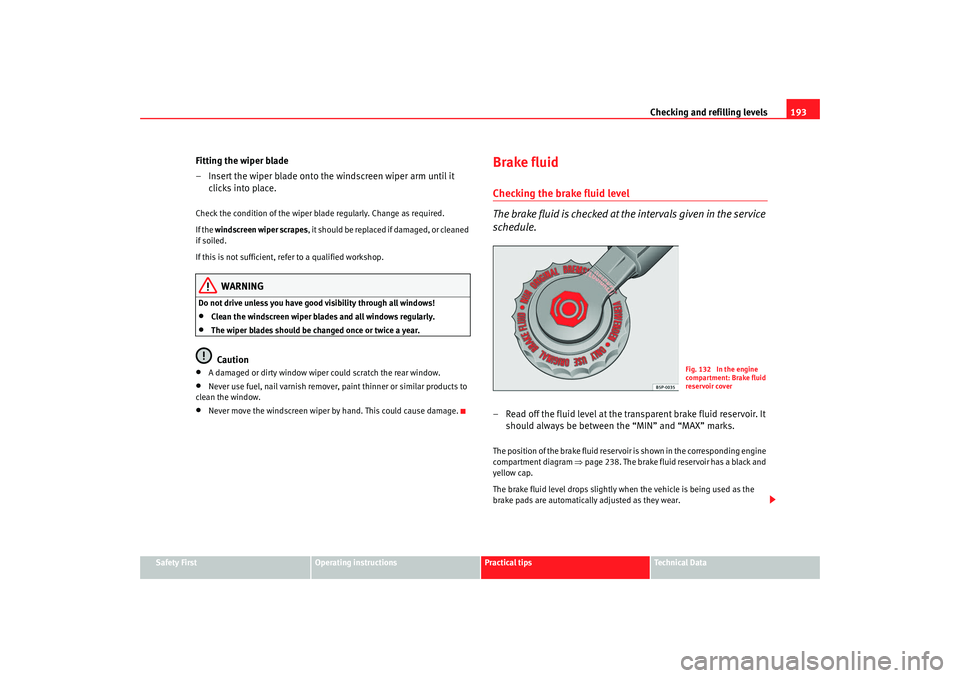
Checking and refilling levels193
Safety First
Operating instructions
Practical tips
Te c h n i c a l D a t a
Fitting the wiper blade
– Insert the wiper blade onto the windscreen wiper arm until it
clicks into place.Check the condition of the wiper blade regularly. Change as required.
If the windscreen wiper scrapes, it should be replaced if damaged, or cleaned
if soiled.
If this is not sufficient, refer to a qualified workshop.
WARNING
Do not drive unless you have good visibility through all windows!•
Clean the windscreen wiper blades and all windows regularly.
•
The wiper blades should be changed once or twice a year.Caution
•
A damaged or dirty window wiper could scratch the rear window.
•
Never use fuel, nail varnish remover, paint thinner or similar products to
clean the window.
•
Never move the windscreen wiper by hand. This could cause damage.
Brake fluidChecking the brake fluid level
The brake fluid is checked at the intervals given in the service
schedule.– Read off the fluid level at the transparent brake fluid reservoir. It should always be between the “MIN” and “MAX” marks.The position of the brake fluid reservoir is shown in the corresponding engine
compartment diagram ⇒page 238. The brake fluid reservoir has a black and
yellow cap.
The brake fluid level drops slightly when the vehicle is being used as the
brake pads are automatically adjusted as they wear.
Fig. 132 In the engine
compartment: Brake fluid
reservoir cover
Ibiza250_angles Seite 193 Dienstag, 5. August 2008 1:11 13
Page 196 of 260
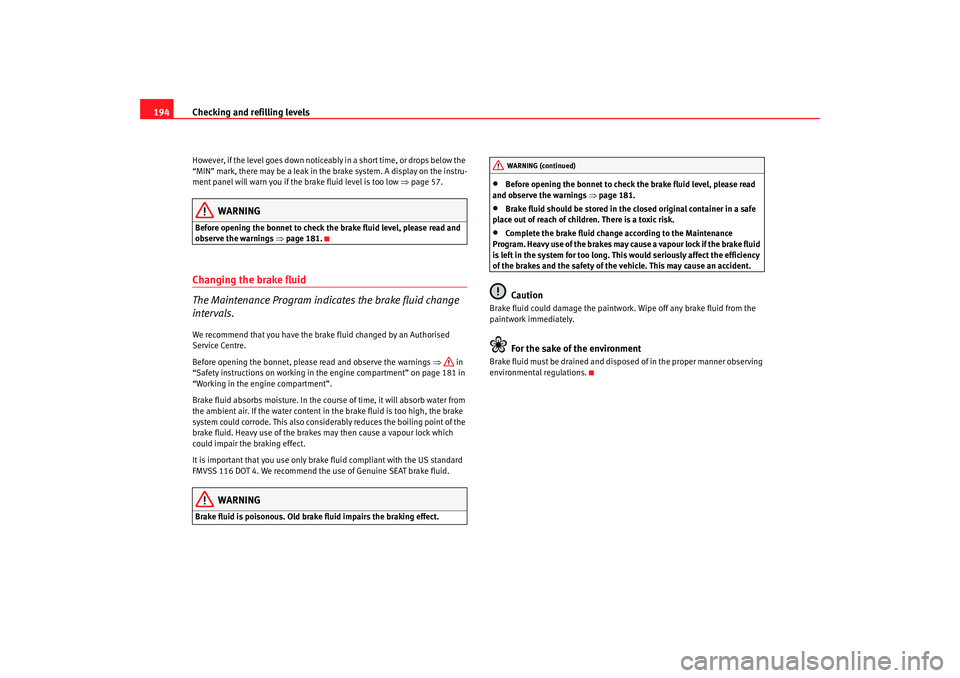
Checking and refilling levels
194However, if the level goes down noticeably in a short time, or drops below the
“MIN” mark, there may be a leak in the brake system. A display on the instru-
ment panel will warn you if the brake fluid level is too low ⇒page 57.
WARNING
Before opening the bonnet to check the brake fluid level, please read and
observe the warnings ⇒ page 181.Changing the brake fluid
The Maintenance Program indicates the brake fluid change
intervals.We recommend that you have the brake fluid changed by an Authorised
Service Centre.
Before opening the bonnet, please read and observe the warnings ⇒ in
“Safety instructions on working in the engine compartment” on page 181 in
“Working in the engine compartment”.
Brake fluid absorbs moisture. In the cour se of time, it will absorb water from
the ambient air. If the water content in the brake fluid is too high, the brake
system could corrode. This also considerably reduces the boiling point of the
brake fluid. Heavy use of the brakes may then cause a vapour lock which
could impair the braking effect.
It is important that you use only brake fluid compliant with the US standard
FMVSS 116 DOT 4. We recommend the use of Genuine SEAT brake fluid.
WARNING
Brake fluid is poisonous. Old brake fluid impairs the braking effect.
•
Before opening the bonnet to check the brake fluid level, please read
and observe the warnings ⇒page 181.
•
Brake fluid should be stored in the closed original container in a safe
place out of reach of children. There is a toxic risk.
•
Complete the brake fluid change according to the Maintenance
Program. Heavy use of the brakes may cause a vapour lock if the brake fluid
is left in the system for too long. Th is would seriously affect the efficiency
of the brakes and the safety of the vehicle. This may cause an accident.Caution
Brake fluid could damage the paintwork. Wipe off any brake fluid from the
paintwork immediately.
For the sake of the environment
Brake fluid must be drained and disposed of in the proper manner observing
environmental regulations.
WARNING (continued)
Ibiza250_angles Seite 194 Dienstag, 5. August 2008 1:11 13
Page 201 of 260
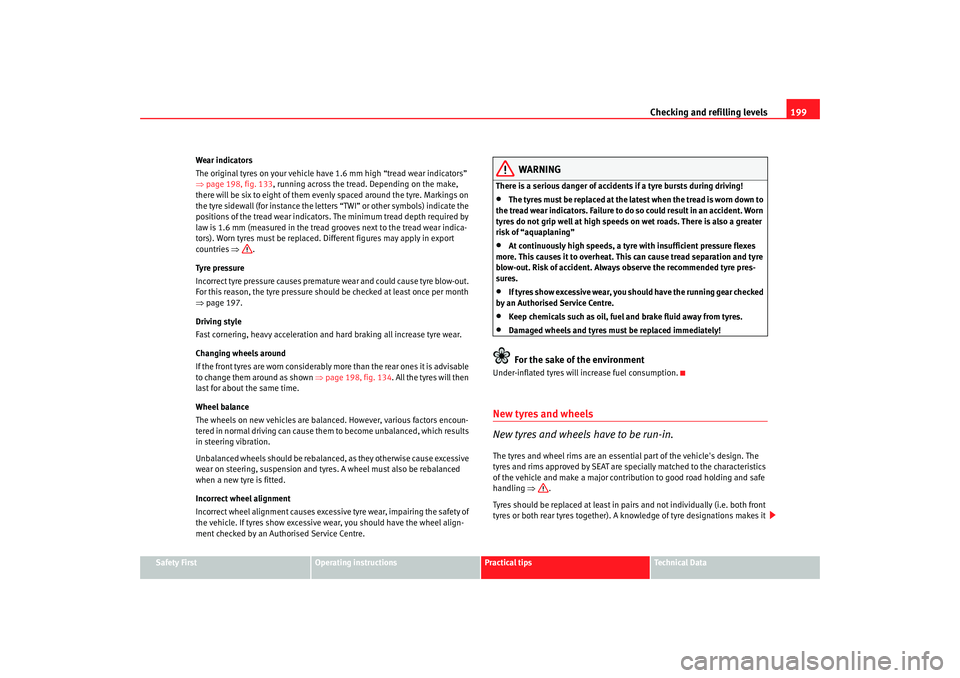
Checking and refilling levels199
Safety First
Operating instructions
Practical tips
Te c h n i c a l D a t a
Wear indicators
The original tyres on your vehicle have 1.6 mm high “tread wear indicators”
⇒
page 198, fig. 133 , running across the tread. Depending on the make,
there will be six to eight of them evenly spaced around the tyre. Markings on
the tyre sidewall (for instance the letters “TWI” or other symbols) indicate the
positions of the tread wear indicators. The minimum tread depth required by
law is 1.6 mm (measured in the tread grooves next to the tread wear indica-
tors). Worn tyres must be replaced. Different figures may apply in export
countries ⇒.
Tyre pressure
Incorrect tyre pressure causes premature wear and could cause tyre blow-out.
For this reason, the tyre pressure should be checked at least once per month
⇒ page 197.
Driving style
Fast cornering, heavy acceleration and hard braking all increase tyre wear.
Changing wheels around
If the front tyres are worn considerably more than the rear ones it is advisable
to change them around as shown ⇒page 198, fig. 134 . All the tyres will then
last for about the same time.
Wheel balance
The wheels on new vehicles are balanced. However, various factors encoun-
tered in normal driving can cause them to become unbalanced, which results
in steering vibration.
Unbalanced wheels should be rebalanced, as they otherwise cause excessive
wear on steering, suspension and tyres. A wheel must also be rebalanced
when a new tyre is fitted.
Incorrect wheel alignment
Incorrect wheel alignment causes excessive tyre wear, impairing the safety of
the vehicle. If tyres show excessive wear, you should have the wheel align-
ment checked by an Authorised Service Centre.
WARNING
There is a serious danger of accidents if a tyre bursts during driving!•
The tyres must be replaced at the latest when the tread is worn down to
the tread wear indicators. Failure to do so could result in an accident. Worn
tyres do not grip well at high speeds on wet roads. There is also a greater
risk of “aquaplaning”
•
At continuously high speeds, a tyre with insufficient pressure flexes
more. This causes it to overheat. This can cause tread separation and tyre
blow-out. Risk of accident. Always observe the recommended tyre pres-
sures.
•
If tyres show excessive wear, you should have the running gear checked
by an Authorised Service Centre.
•
Keep chemicals such as oil, fuel and brake fluid away from tyres.
•
Damaged wheels and tyres must be replaced immediately!For the sake of the environment
Under-inflated tyres will increase fuel consumption.New tyres and wheels
New tyres and wheels have to be run-in.The tyres and wheel rims are an essential part of the vehicle's design. The
tyres and rims approved by SEAT are specially matched to the characteristics
of the vehicle and make a major contribution to good road holding and safe
handling ⇒.
Tyres should be replaced at least in pair s and not individually (i.e. both front
tyres or both rear tyres together). A knowledge of tyre designations makes it
Ibiza250_angles Seite 199 Dienstag, 5. August 2008 1:11 13
Page 240 of 260
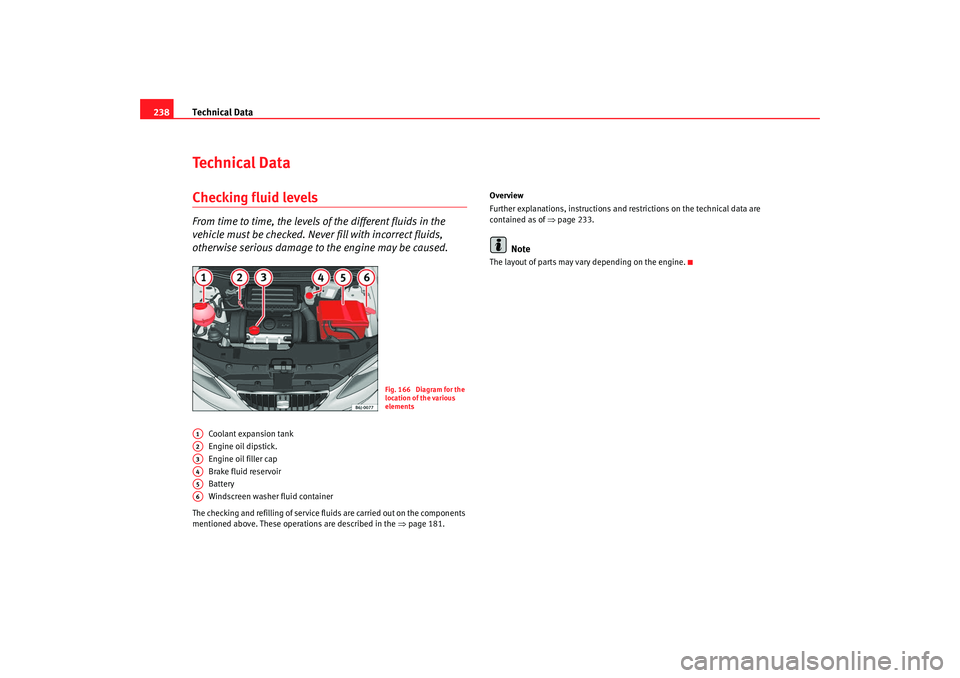
Technical Data
238Te c h n i c a l D a t aChecking fluid levelsFrom time to time, the levels of the different fluids in the
vehicle must be checked. Never fill with incorrect fluids,
otherwise serious damage to the engine may be caused.
Coolant expansion tank
Engine oil dipstick.
Engine oil filler cap
Brake fluid reservoir
Battery
Windscreen washer fluid container
The checking and refilling of service fluids are carried out on the components
mentioned above. These operations are described in the ⇒page 181. Overview
Further explanations, instructions and restrictions on the technical data are
contained as of
⇒page 233.
Note
The layout of parts may vary depending on the engine.
Fig. 166 Diagram for the
location of the various
elements
A1A2A3A4A5A6
Ibiza250_angles Seite 238 Dienstag, 5. August 2008 1:11 13
Page 251 of 260
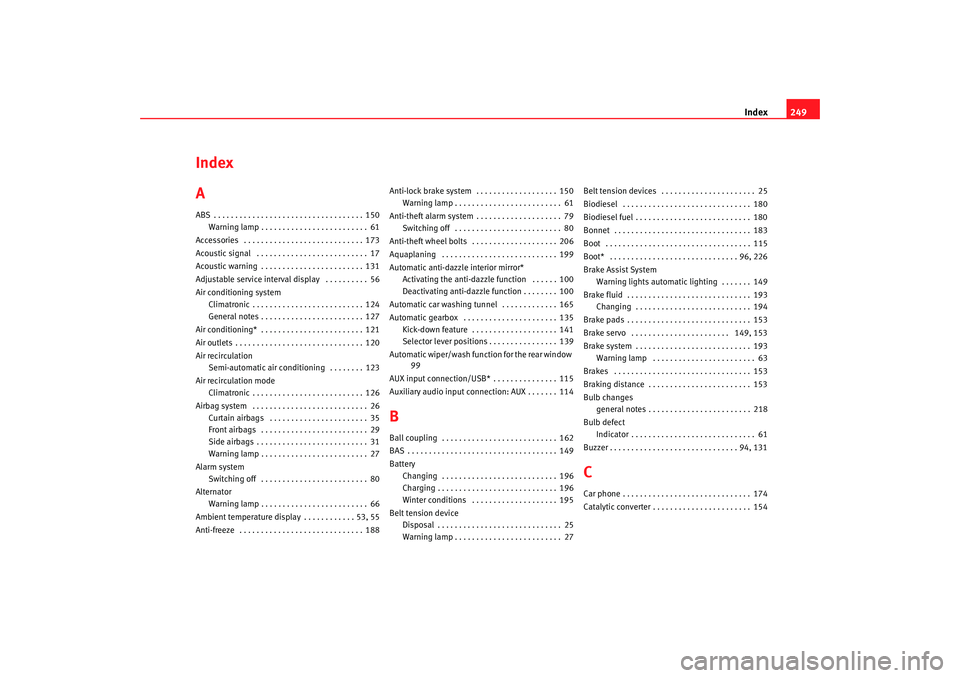
Index249
Index
AABS . . . . . . . . . . . . . . . . . . . . . . . . . . . . . . . . . . . 150
Warning lamp . . . . . . . . . . . . . . . . . . . . . . . . . 61
Accessories . . . . . . . . . . . . . . . . . . . . . . . . . . . . 173
Acoustic signal . . . . . . . . . . . . . . . . . . . . . . . . . . 17
Acoustic warning . . . . . . . . . . . . . . . . . . . . . . . . 131
Adjustable service interval display . . . . . . . . . . 56
Air conditioning system Climatronic . . . . . . . . . . . . . . . . . . . . . . . . . . 124
General notes . . . . . . . . . . . . . . . . . . . . . . . . 127
Air conditioning* . . . . . . . . . . . . . . . . . . . . . . . . 121
Air outlets . . . . . . . . . . . . . . . . . . . . . . . . . . . . . . 120
Air recirculation Semi-automatic air conditi oning . . . . . . . . 123
Air recirculation mode Climatronic . . . . . . . . . . . . . . . . . . . . . . . . . . 126
Airbag system . . . . . . . . . . . . . . . . . . . . . . . . . . . 26 Curtain airbags . . . . . . . . . . . . . . . . . . . . . . . 35
Front airbags . . . . . . . . . . . . . . . . . . . . . . . . . 29
Side airbags . . . . . . . . . . . . . . . . . . . . . . . . . . 31
Warning lamp . . . . . . . . . . . . . . . . . . . . . . . . . 27
Alarm system Switching off . . . . . . . . . . . . . . . . . . . . . . . . . 80
Alternator Warning lamp . . . . . . . . . . . . . . . . . . . . . . . . . 66
Ambient temperature display . . . . . . . . . . . . 53, 55
Anti-freeze . . . . . . . . . . . . . . . . . . . . . . . . . . . . . 188 Anti-lock brake system . . . . . . . . . . . . . . . . . . . 150
Warning lamp . . . . . . . . . . . . . . . . . . . . . . . . . 61
Anti-theft alarm system . . . . . . . . . . . . . . . . . . . . 79 Switching off . . . . . . . . . . . . . . . . . . . . . . . . . 80
Anti-theft wheel bolts . . . . . . . . . . . . . . . . . . . . 206
Aquaplaning . . . . . . . . . . . . . . . . . . . . . . . . . . . 199
Automatic anti-dazzle interior mirror* Activating the anti-dazzle function . . . . . . 100
Deactivating anti-dazzle function . . . . . . . . 100
Automatic car washing tunnel . . . . . . . . . . . . . 165
Automatic gearbox . . . . . . . . . . . . . . . . . . . . . . 135 Kick-down feature . . . . . . . . . . . . . . . . . . . . 141
Selector lever positions . . . . . . . . . . . . . . . . 139
Automatic wiper/wash function for the rear window 99
AUX input connection/USB* . . . . . . . . . . . . . . . 115
Auxiliary audio input connection: AUX . . . . . . . 114
BBall coupling . . . . . . . . . . . . . . . . . . . . . . . . . . . 162
BAS . . . . . . . . . . . . . . . . . . . . . . . . . . . . . . . . . . . 149
Battery Changing . . . . . . . . . . . . . . . . . . . . . . . . . . . 196
Charging . . . . . . . . . . . . . . . . . . . . . . . . . . . . 196
Winter conditions . . . . . . . . . . . . . . . . . . . . 195
Belt tension device Disposal . . . . . . . . . . . . . . . . . . . . . . . . . . . . . 25
Warning lamp . . . . . . . . . . . . . . . . . . . . . . . . . 27 Belt tension devices . . . . . . . . . . . . . . . . . . . . . . 25
Biodiesel . . . . . . . . . . . . . . . . . . . . . . . . . . . . . . 180
Biodiesel fuel . . . . . . . . . . . . . . . . . . . . . . . . . . . 180
Bonnet . . . . . . . . . . . . . . . . . . . . . . . . . . . . . . . . 183
Boot . . . . . . . . . . . . . . . . . . . . . . . . . . . . . . . . . . 115
Boot* . . . . . . . . . . . . . . . . . . . . . . . . . . . . . . 96, 226
Brake Assist System
Warning lights auto matic lighting . . . . . . . 149
Brake fluid . . . . . . . . . . . . . . . . . . . . . . . . . . . . . 193 Changing . . . . . . . . . . . . . . . . . . . . . . . . . . . 194
Brake pads . . . . . . . . . . . . . . . . . . . . . . . . . . . . . 153
Brake servo . . . . . . . . . . . . . . . . . . . . . . . 149, 153
Brake system . . . . . . . . . . . . . . . . . . . . . . . . . . . 193 Warning lamp . . . . . . . . . . . . . . . . . . . . . . . . 63
Brakes . . . . . . . . . . . . . . . . . . . . . . . . . . . . . . . . 153
Braking distance . . . . . . . . . . . . . . . . . . . . . . . . 153
Bulb changes general notes . . . . . . . . . . . . . . . . . . . . . . . . 218
Bulb defect Indicator . . . . . . . . . . . . . . . . . . . . . . . . . . . . . 61
Buzzer . . . . . . . . . . . . . . . . . . . . . . . . . . . . . . 94, 131
CCar phone . . . . . . . . . . . . . . . . . . . . . . . . . . . . . . 174
Catalytic converter . . . . . . . . . . . . . . . . . . . . . . . 154
Ibiza250_angles Seite 249 Dienstag, 5. August 2008 1:11 13